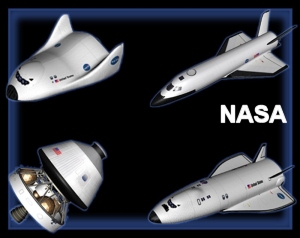
NASA today released the top level requirements for the Orbital Space Plane (OSP), a next generation system of space vehicles designed to provide a crew rescue and crew transport capability to and from the International Space Station. These requirements set the foundation for the design of the vehicle and its associated systems.
The Level I requirements for an OSP system were developed based on NASA's missions, as defined in the Integrated Space Transportation Plan, input from industry and Department of Defense partners participating in the program. The requirements were reviewed at multiple levels within NASA. The final review and approval process included the NASA Administrator, Deputy Administrator, Associate Administrator for the Office of Aerospace Technology, and the Associate Administrator, Office of Space Flight.
"This is an important first step in making the Integrated Space Transportation Plan a reality," said NASA Deputy Administrator Frederick Gregory. "The Orbital Space Plane system will give us the flexibility needed to safely and efficiently get crew to and from orbit and to provide crew rescue and logistical support to the International Space Station. These initial requirements help to outline a comprehensive system that will significantly complement the
capabilities of our existing Space Shuttle fleet," he said.
Any future changes to the Level I Requirements would be considered by the Orbital Space Plane Program Office and require approval from the NASA Executive Council.
The program is in the process of developing Level II Requirements for the OSP system. Unlike the Level I requirements, which were defined by NASA, Level II requirements will be defined at the program level and will be detailed in a document referred to as the Systems Requirements Document (SRD) planned for release no later than late 2003.
Orbital Space Plane Program LevelⅠ One Requirements
Mission Needs StatementThe vehicle(s) and associated systems will support U.S. International Space Station requirements for crew rescue, crew transport, and cargo.
Requirements
1. The system, which may include multiple vehicles, shall provide rescue* capability for no fewer than four ISS crew as soon as practical but no later than 2010.
2. The system shall provide rescue capability that allows the safe return of de-conditioned, ill or injured crewmembers with ongoing treatment until arrival at definitive medical care within 24 hours. Crew should not require suits in the vehicle, but the vehicle should support crewmembers wearing suits if the situation warrants.
3. The system for rescue shall provide for rapid separation from the ISS under emergency conditions followed by return to Earth.
4. Safety requirements ュ system for crew rescue:
a. The availability (defined as "a full-up vehicle able to perform its mission") for the escape mission shall be at least: Objective: 99% Minimum Threshold: 95%.
b. The risk of loss of crew shall be, with high confidence, lower than the Soyuz for the rescue mission.
5. The system shall provide transportation capability for no fewer than four crew, to and from the International Space Station, as soon as practical, but no later than 2012.
6. Safety requirement ュ system for crew transport: The risk of loss of crew shall be, with high confidence, lower than the Space Shuttle for the transport mission.
7. The system shall be designed for minimum life cycle cost.
8. The system shall meet all applicable ISS requirements for visiting and attached vehicles.
9. Compared to the Space Shuttle, the system shall require less time to prepare and execute a mission and have increased launch probability.
10. Compared to the Space Shuttle, the system shall have increased on-orbit maneuverability.
Operations Concepts
1. The vehicle(s) shall initially launch on an ELV.
2. The system shall be operated through at least 2020. However, the system should be designed so that it could be operated for a longer time.
3. NASA envisions that the systems for crew rescue and crew transport could be different versions of the same vehicle design.
4. The system shall provide contingency capability for cargo delivery to or from the ISS to support a minimal level of science.
5. The system shall support a nominal ISS crew rotation period of 4-6 months.
* Rescue includes medical evacuation and emergency evacuation.